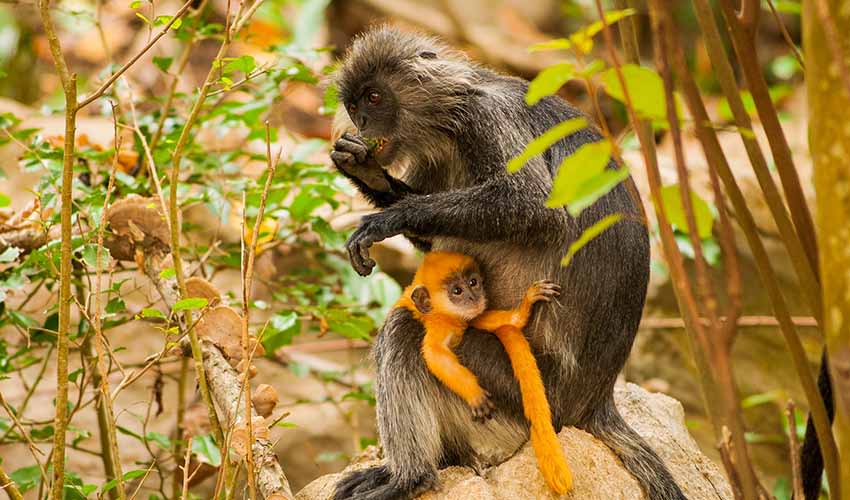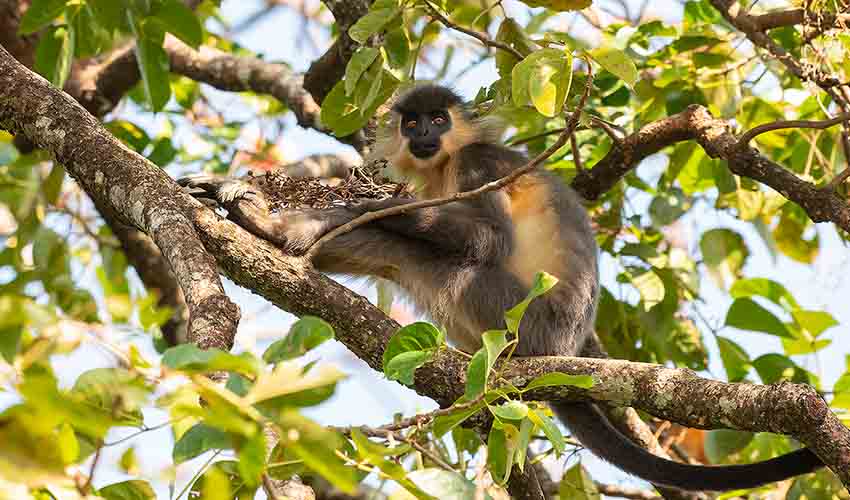Trachypith’ – Lutungs
Completely change their fur color when they grow up
Lutungs, also commonly known as langurs, are a group of Old World monkeys that inhabit the diverse landscapes of Southeast Asia. Characterized by their medium size and agile nature, lutungs are primarily arboreal, spending the majority of their lives high in the canopy of lush rainforests and mountainous forests.
Langurs strongly prefer dense, tropical rainforests, where the thick foliage offers ample food resources and protection from predators. However, their adaptability allows them to thrive in various forest types, including mountain forests, where the climate and vegetation differ significantly from the lowland rainforests. Their physical adaptations, such as strong limbs and a tail that aids in balance, are crucial for navigating the complex three-dimensional space of the forest canopy.
These primates are primarily diurnal rather than nocturnal. They exhibit peak activity levels during the cooler hours of early morning and late afternoon, avoiding the midday heat by resting in the shade of the forest canopy. This behavioral adaptation helps them conserve energy and avoid exposure to predators during the hottest parts of the day. Lutungs rarely descend to the ground, highlighting their dependence on the arboreal environment for safety, food, and social interaction.
Social grooming plays a significant role in lutung societies. It is a vital social bonding activity that helps to maintain and reinforce the hierarchical structure and cohesion within groups. This behavior helps remove parasites and maintain fur health and facilitates social interactions and the establishment of alliances among group members.
Lutungs are primarily folivorous, with a diet emphasizing leaves as a major food source. Their specialized digestive system allows them to process the cellulose in leaves more efficiently than many other primates. In addition to mature and young leaves, their diet includes fruits (ripe and unripe), seeds, buds, and flowers. This varied diet reflects their ability to exploit the diverse plant resources available in their forest habitats.
Species in this genus
Cat Ba langur
Among the most endangered primates in the world, and potentially the most endangered primate in Asia
Delacours langur
It has a local Vietnamese name that translates to ‘langur with white pants,’ derived from their coat markings
White-headed langur
As its name suggests, it has a striking white head, which stands out against its dark body
François’ langur
Known as the “white side-burned monkey” thanks to the dramatic tufts of white hair along its cheeks
Dusky leaf monkey
The gentle vegetarians of the forest
Germain’s langur
Newborns aren’t just orange—they’re bright neon orange
Indochinese grey langur
Its scientific name crepusculus means “twilight” in Latin, referring to its soft, dusky-gray coat
Capped langur
Have multi-chambered stomachs filled with bacteria that help digest tough leaves—much like a cow’s digestive system!









